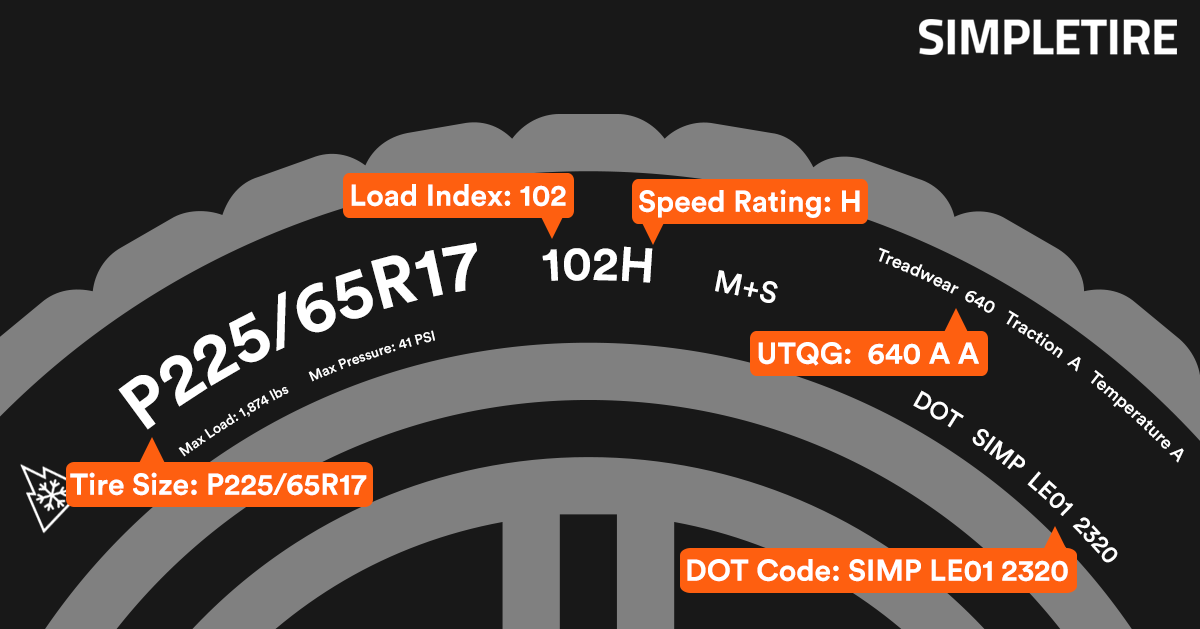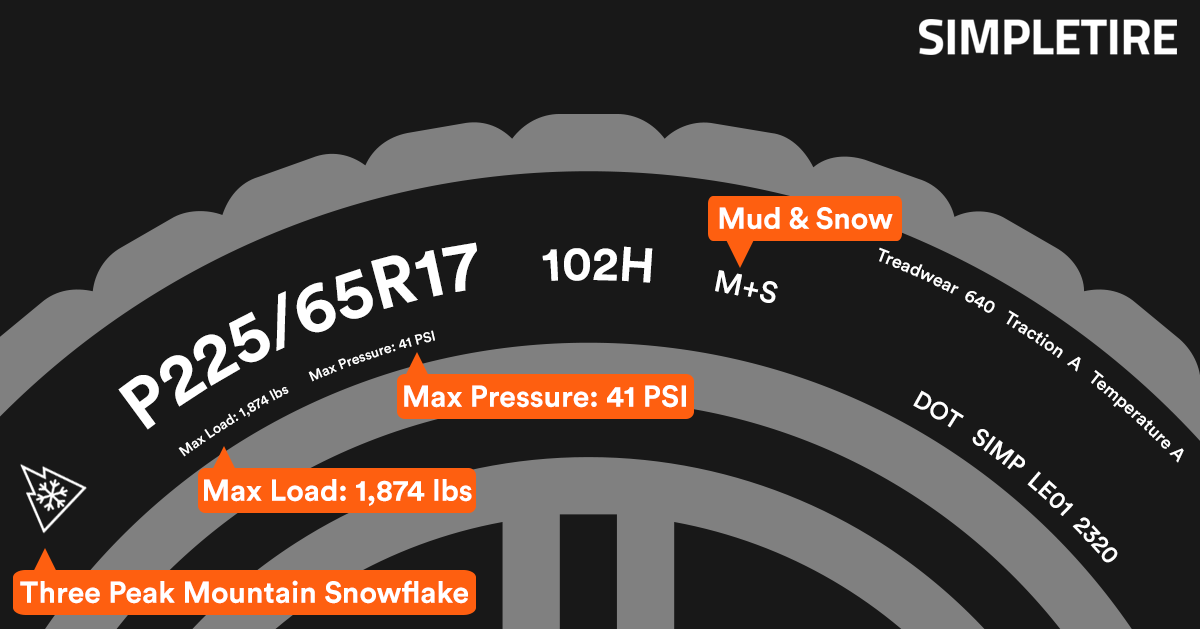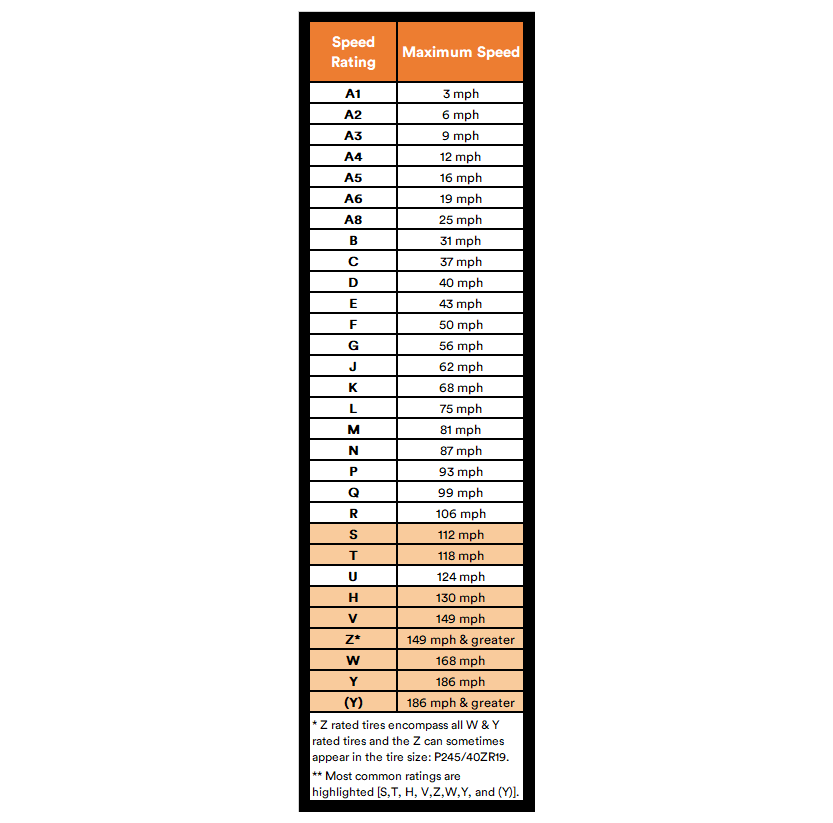Tire Buying Guides
Best price guarantee
Tire replacement coverage
24/7 roadside assistance
Easy returns
Tire Sidewall Markings Explained: A Beginner's Guide

For many vehicle owners, deciphering the cryptic codes and markings on their tire sidewalls can feel like trying to read a foreign language. However, understanding these numbers and letters is important for ensuring optimal tire performance, safety, and longevity.
By familiarizing yourself with the meaning behind tire sidewall markings, you can make informed decisions when purchasing new tires or maintaining your current set. Armed with this knowledge, you'll be better equipped to select tires that suit your specific vehicle, driving style, and road conditions.
In this article, we'll break down the various components of a tire sidewall, providing you with the tools to decode these important markings. From tire size and load index to speed ratings and manufacturing dates, we'll cover all the essential information you need to know.
What Do Tire Sidewall Numbers Mean?

Tire sidewall markings provide a wealth of information about a tire's size, construction, performance capabilities, and more. Two of the most important aspects to understand amongst these are tire size and load index/speed rating.
Tire Size
The tire size is represented by a series of numbers and letters, typically in the format P215/65R15. Here's what each part means:
- The first letter (e.g., P) indicates the tire type—in this case, "P" stands for passenger car tire. Other common designations include "LT" for light truck tires and "ST" for special trailer tires.
- The first three-digit number (e.g., 215) represents the tire's width in millimeters from sidewall to sidewall.
- The two-digit number following the slash (e.g., 65) is the aspect ratio, which is the sidewall height as a percentage of the tire's width. In this example, the sidewall height is 65% of the tire's width.
- The letter "R" indicates radial construction, which is the most common type of tire construction today.
- The final two-digit number (e.g., 15) denotes the diameter of the wheel rim in inches.
Load Index and Speed Rating
Following the tire size, you'll usually find a two- or three-digit number and a letter (e.g., 95H). This combination represents the tire's load index and speed rating.
The load index is a numerical code indicating the maximum weight a tire can support when properly inflated. For example, a load index of 95 means the tire can support up to 1,521 pounds. It's essential to choose tires with a load index that meets or exceeds your vehicle's requirements.

The speed rating, represented by a letter, indicates the maximum speed at which the tire can safely operate. Common speed ratings include:
- S: Up to 112 mph
- T: Up to 118 mph
- H: Up to 130 mph
- V: Up to 149 mph
- Z: 149+ mph

When selecting tires, ensure that the speed rating matches or surpasses your vehicle's top speed and your typical driving conditions. Tires with higher speed ratings often provide better handling and stability at higher speeds but may also have shorter tread life and a firmer ride.
By understanding tire size, load index, and speed rating, you can make informed choices when buying tires—ensuring that you select options that are compatible with your vehicle and well-suited to your driving needs. This knowledge can help you optimize your vehicle's performance, safety, and efficiency while also maximizing tire longevity.
How to Determine the Age of Your Tires
Recognizing a tire's age is crucial for maintaining optimal safety and efficiency. Over time, the materials in tires degrade, affecting their performance. To ascertain their age, locate the tire's sidewall and find the DOT (Department of Transportation) code, which provides essential manufacturing information.
Decoding the DOT Code
The DOT code delivers valuable data about when a tire was crafted. This sequence ends with a four-digit number that specifies the production timeline. Here's how to interpret it:
- Last Four Digits: These numbers reveal the week and year of manufacture. The first two digits indicate the week number (ranging from 01 to 52), while the last two digits represent the year. For example, a code ending in "3323" indicates the tire was produced during the 33rd week of 2023.
- Significance of the Code: This information helps gauge how long the tire has been in use, informing decisions about maintenance and replacement.
Why Tire Age Matters
As tires age, they are more prone to failure due to environmental factors like heat and sunlight, which degrade rubber compounds. Industry guidelines recommend:
- Six-Year Check: Tires that have been in service for six years should be regularly inspected by a professional to ensure they are still fit to use.
- Ten-Year Limit: Any tire reaching ten years from its manufacturing date should be replaced, irrespective of its visual condition or tread depth.
Checking the DOT code regularly will help you monitor your tires' age, ensuring timely replacements and maintaining safety standards.
Decoding Tire Service Descriptions
Understanding tire service descriptions is vital for choosing the best tire for your vehicle's specific needs. These descriptions, typically located at the beginning of the tire size sequence, offer insights into the tire's purpose and load capacity. Recognizing these markings ensures you select tires aligned with your vehicle's requirements and driving scenarios.
Passenger Car Tires
For tires tailored to passenger vehicles, look for those beginning with the designation "P-metric." This classification signifies a tire designed to balance comfort, handling, and longevity for everyday use. An example, like P215/60R16 94H, reflects a tire crafted for optimal performance on standard roadways, providing a smooth and reliable driving experience.
Passenger tires are versatile, making them suitable for sedans, smaller SUVs, and coupes. They focus on delivering a comfortable ride with ample traction and durability for urban and highway conditions. When selecting these tires, consider your typical driving environment and style to ensure enhanced performance and safety.
Light Truck Tires
For vehicles requiring robust load capacities, "LT" marked tires are designed to meet these demands. This marking indicates tires engineered for the rigorous conditions faced by light trucks, SUVs, and larger vehicles used for both work and leisure. For instance, an LT245/75R16 120/116Q tire is equipped to handle increased load and towing requirements, making it ideal for off-road or heavy-duty tasks.
Constructed with reinforced materials, light truck tires often feature deeper tread patterns to improve traction on challenging terrains. Designed to manage the stresses of carrying cargo and towing, they ensure stability and safety across diverse conditions. When choosing light truck tires, consider factors like payload demands, terrain, and weather to select the best fit for your vehicle's duties.
Understanding Tire Tread Wear Indicators
Tire tread wear indicators are integral to monitoring tire condition. These are small, raised bars strategically placed within the grooves of the tire tread. As the tread wears down to the height of these indicators, it serves as a clear signal that the tire has reached its minimum safe tread depth, necessitating replacement to uphold safety standards.
It's important to regularly check tread depth to ensure continued traction and handling performance. One straightforward method is the coin test: place a quarter into the tread groove with George Washington’s head facing down. If the top of Washington’s head is visible, the tread depth is below 4/32 inch, signaling that it's time to consider new tires for optimal safety.
For more precise measurements, use a tread depth gauge to determine the remaining tread. This tool provides an exact reading, allowing for timely tire replacement before they become a risk on the road. Regular evaluation of tread wear indicators and tread depth is crucial in maintaining vehicle safety and performance.
Tire Sidewall Markings for Winter Traction
Selecting tires that can handle icy roads and snowy landscapes is crucial for maintaining safety and control during winter. Key tire sidewall markings can guide you to the best options for winter performance. The three-peak mountain snowflake (3PMSF) symbol is a reliable indicator of a tire's capability in harsh winter conditions. This emblem signifies that the tire has been rigorously tested and meets specific traction performance criteria in snow, ensuring it provides the grip and stability needed to handle challenging winter conditions effectively.
Although many tires may feature an M+S (Mud and Snow) marking, this alone does not serve as a definitive measure of winter performance. The M+S designation indicates a tread pattern designed for improved performance in mud and snow compared to standard tires, but it does not undergo the same standardized testing as the 3PMSF. To guarantee a tire's winter readiness, the 3PMSF symbol stands as the benchmark, confirming superior traction and braking performance on snow-covered roads.
Prioritizing the 3PMSF mark on tire sidewalls offers assurance of safety and performance in winter driving. Winter tires are crafted with specialized rubber compounds that remain flexible in cold temperatures, ensuring optimal contact with the road. Their tread designs effectively channel snow and slush away, reducing slip risk and enhancing handling. For drivers encountering severe winter conditions, selecting tires with the 3PMSF symbol is essential for reliable and safe travel.
Deciphering the Tire Serial Number
The tire serial number, often referred to as the DOT code, is a key identifier on the tire sidewall. This code provides essential details about the tire's production, including its manufacturing location and specific production timeline. Understanding this sequence helps ensure that you are purchasing fresh, reliable tires for your vehicle.
Breaking Down the DOT Code
The DOT code begins with the letters "DOT," followed by a series of characters that reveal insights into the tire's origin and specifications. Here's how to interpret these characters:
- Plant Code: The first two characters after "DOT" denote the manufacturing plant. This code is unique to each facility, which can help in tracing the tire back to its production site. Knowing the plant code is useful for researching the manufacturing standards of that facility.
- Production Timeframe: Rather than focusing solely on the last four digits, consider the entire code for a comprehensive understanding. These digits indicate the week and year of manufacture, offering insights into the tire's age. This information aids in determining how long the tire has been in circulation, which is crucial for assessing its suitability.
Additional Characters and Their Significance
The characters between the plant code and the production timeframe can provide further information about the tire's construction:
- Specification Codes: These characters may include details about the tire's model, design, or specific features. Although not typically used by consumers, these codes can be critical for manufacturers and retailers in tracking and identifying specific batches or design variations.
Understanding the complete DOT code empowers you as a consumer, allowing you to verify that your tires are suitable and have not been sitting in storage for extended periods. By regularly checking these codes, you can maintain both performance and peace of mind on the road, avoiding potential safety risks associated with aged or improperly stored tires.
Making Sense of Tire Ratings
Tire ratings offer valuable insights into the performance characteristics of tires, helping drivers make well-informed decisions when selecting the right set for their needs. These ratings cover various aspects of a tire’s capabilities, which are crucial for aligning with your driving habits and conditions.
Treadwear Rating
Treadwear ratings provide an estimate of the tire's durability relative to a standardized baseline, which is rated at 100. A higher treadwear number points to a longer expected tread life. For example:
- 300: This indicates the tire is expected to last three times as long as the reference tire.
- 500: A tire with this rating should last five times longer than the baseline.
These numbers act as a guideline for potential longevity, helping you select tires that suit your driving frequency and financial planning. It's important to note that actual tread life can vary based on factors such as driving habits and road conditions, making these ratings a general reference point.
Traction and Temperature Ratings
Understanding traction and temperature ratings is essential for evaluating a tire's safety and performance. Traction ratings, which range from AA to C, measure the tire's grip on wet roads. An AA rating represents superior wet traction, while a C rating offers standard performance. These ratings ensure that your tires provide the necessary grip to prevent hydroplaning and enhance braking efficiency in wet conditions.

Temperature ratings, denoted from A to C, indicate a tire's ability to manage heat. An A rating signifies excellent heat resistance, vital for maintaining tire integrity at high speeds or in hot climates. Tires with higher temperature ratings are less likely to overheat, reducing the risk of tire failure.

By understanding and utilizing these ratings, you can effectively compare tires to identify those that best meet your driving conditions and performance expectations. These ratings serve as a comprehensive tool for enhancing safety, performance, and tire longevity.
By familiarizing yourself with tire sidewall markings, you can make informed decisions about tire selection, maintenance, and safety. Understanding these codes empowers you to choose the right tires for your vehicle and driving needs, ensuring optimal performance and longevity on the road. When you're ready to shop for tires online and find the best deals, we invite you to explore our extensive selection at SimpleTire, where our commitment to affordability and expert guidance makes the tire-buying process simple and stress-free.
Ready to find the perfect tires?
Search By